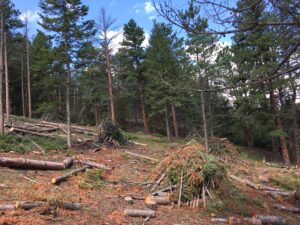
Why Can’t We Just Cut It? Why Prescribed Fire is Here to Stay
Throughout the year, chainsaws, mowers, mulchers, and machinery work to thin out overgrown forests and shrublands that we’ve “protected” from fire for over a century. Ideally, because we live in a fire-dependent ecosystem, this mechanized work is followed by a healing dose of these forests’ first medicine – fire. Returning this natural process to the land is a critical step in restoring the resiliency of northern Colorado forests. It resuscitates, nourishes, and reactivates the ecosystem’s natural ability to recover after wildfire and remain intact for future generations.
Although most of us understand and support the need for restoring healthy forests and reducing wildfire risk, the following question is still common: “Why can’t we just cut it and skip the fire part?” So, here’s a quick primer on why partnering with fire instead of banishing it again will always provide better outcomes for nature, society, and the future of both.

Nature’s Affordable Multi-tasker
Using mechanical methods alone to thin out the forest canopy will stimulate beneficial growth, but following up with fire is ideal. Thinning without applying prescribed fire is like weeding your garden without ever planting anything in it. The weeds are gone for the moment, but nothing desirable is growing. Prescribed fire does the weeding and the seeding and the fertilizing. It creates superior results that can’t be duplicated through artificial means while supporting the longevity of the forests we treasure. It does this affordably, in days instead of months, across vast areas – much of which is inaccessible to road-dependent cutting machinery. Even where machines can do the heavy lifting of forest treatments, adding fire provides the best results.
Life Support
Cutting alone doesn’t provide all of the ecological boosts that prescribed fire contributes to the forest, and the fire-dependent plants and animals miss out. Elk forage on nutritious new grasses that sprout quickly after a burn. Bees busy themselves on newly emerging wildflowers, pollinating their way through a rejuvenated landscape.
Your favorite aspen grove is an important source of food and shelter for wildlife, and the heat of fire triggers new growth. Fire supports ponderosa pines too. It prepares the ground for seedling success by exposing mineral soil and clearing out the competition while consuming shade-making tree species that steal sunlight and stifle new growth.
Wildfire Tamer and Watershed Hero
When wildfires burn into areas that have experienced prescribed burning and/or cutting, the behavior of the fire typically calms down. They cause less damage, are easier to control and are safer for firefighters. Firefighters saw this with the Cameron Peak Fire of 2020. While they’re doing their work, prescribed fires burn cooler than wildfires, protecting the soil’s natural ability to absorb and distribute precipitation. The extreme heat of an intense wildfire can cancel out this ability and make the soil water-repellent instead, causing subsequent rainfall to puddle uselessly or race downslope, carrying soil and ash with it. If this occurs over large swaths of the landscape it puts drinking water supplies at risk. We are seeing this now in watersheds that were burned by major fires in 2020, including the Poudre River, Big Thompson, and Estes Valley watersheds.
Don’t Throw the Baby Out with the Bathwater
Let’s not throw out something good when trying to fix something bad. Look at it this way – we don’t cut off our legs when they’re caked with mud, aching, and scraped up after a mountain bike ride. We shower them down, break out the ice pack, and grab a Band-Aid so they can heal and peddle us up another single-track next weekend. We give them what they need to repair themselves and get stronger. To exclude fire again would be to deny the forest the exact remedy that can heal it. We would be recklessly dismissing decades of lessons learned, successful forest restoration, and progress towards safer communities. We use prescribed fire to save the forest and all the life that relies on it, including ourselves. This time around, we’ve learned our lesson. This time fire is here to stay.
Top Photo: A firefighter from the Canyon Lakes Ranger District uses a drip torch to light a prescribed fire at the Magic Feather Prescribed Burn in June 2021. The U.S. Forest Service successfully burned 70 acres during the prescribed fire operation (Evan Barrientos/Northern Colorado Fireshed Collaborative)